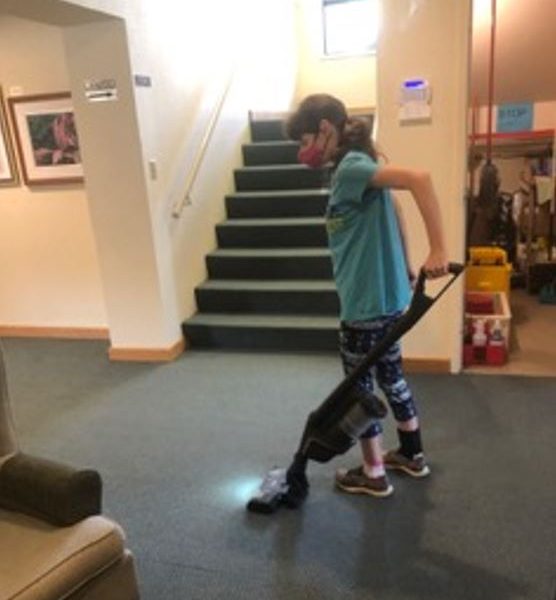TD Snap

AAC apps and devices tend to be highly specialized and expensive pieces of hardware, which is probably why we haven’t spent that much time talking about them. These devices also tend to be recommended by speech language pathologists, so we would always recommend first meeting with a member of the New Brunswick Association of Speech-Language Pathologists and Audiologists if you or someone you know might benefit from this type of technology.
However, the app that we are looking at today is a fraction of the cost of a typical piece of AAC hardware, and rather than having to buy a new piece of standalone technology, TD Snap harnesses the power of iOS to transform an iPad into an AAC device. This also means that persons with disabilities have even more customization and accessibility options due to iOS’s built-in features. Thanks to those built-in accessibility features, the app can be accessed via touch, voice commands, eye gaze, and switch.
Grammarly: The Anywhere Writing App

Word processing apps have evolved dramatically since the advent of the internet. In the early days of computing, word processing apps were expensive, tedious, and often required extensive training to use. Then, Microsoft Word streamlined the genre and made it more accessible and easier to use. Then, with the popularity of smartphones came a flood of mobile-based word processing and grammar apps designed to help users write while on the go.
Today we are going to look at one of the most popular (certainly the most widely known) app in that category, Grammarly. The app is free, but there is also a premium version with even more features. We’re going to take a closer look at those features today and do a bit of comparing between the two versions of the app.
SnapType

For individuals with fine motor or other handwriting-related challenges, completing worksheets in a timely manner may seem like an insurmountable struggle. Of course, we know that there are Optical Character Recognition (OCR) apps such as Prizmo Go or Office Lens that are designed to capture and digitize text, but those apps are more suited for capturing large chunks of text from a textbook or document with the purpose of having it read aloud.
We Have Solutions! – Episode 11: Speech Loss, New Technology, and App Recommendations with Nakia Singh

On this episode we are joined once again by Nakia Singh. We explore some interesting new assistive technology apps and devices including a solar powered keyboard, a distraction-free browser, a wearable metronome and more. We also explore a new case study involving an individual dealing with speech loss at an advanced age.
Kurzweil 3000

Most of the AT that we cover is fairly specific in its functionality, but today we are going to look at an app that functions more like an assistive technology suite, providing multiple functions and features designed for multiple learning challenges.
Kurzweil 3000 is a literacy tool that is designed to assist with reading, writing, comprehension, and test-taking, and it does so within one unified app. The software is expensive, especially when compared to the cost of an iPad which has most of Kurzweil’s features already built-in for free, but if you struggle in ALL of the areas listed above, it could be worth considering, especially if you are used to a Windows-based learning environment.
Notability

We’ve covered lots of other notetaking and annotation apps in the past, but we’ve somehow neglected to cover one of the most powerful note-taking tools for iOS. Notability is a multi-media note-taking app that does everything you’d expect and more. The app would be a great choice for many persons with learning disabilities as it provides multiple means of recording and representation, plus it pairs well with Apple’s built-in accessibility features for iOS.
Adobe Scan

Optical Character Recognition (OCR) and scanning apps are great for capturing and digitizing physical text such as documents, whiteboards, textbooks, and more. We’ve already mentioned Office Lens, PrizmoGo, and other OCR apps in previous e-bulletins, but when it comes to OCR apps (and AT in general) it’s always good to have multiple options at hand in case one app works better than the other.
Today we’re going to look at Adobe’s free OCR app, Adobe Scan. To use Adobe Scan, you simply open the app, select the type of text you would like to capture, and hit the camera button. Supported text formats include whiteboard, book, document, ID card, and business card.
Marcie’s Job Becomes Easier and Safer With Assistive Technology

Marcie works as a custodian at a church in Salmon Arm.
Marcie had a stroke several years ago, which has left her with hemiparesis — weakness — on her right side. This made using a traditional heavy vacuum with a cord — particularly on the stairs — difficult, and even dangerous for her. The church’s vacuums were unwieldy and awkward for her to use.
Her vocational counsellor at the Shuswap Association for Community Living referred her to WorkBC Assistive Technology Services.
ClaroSpeak Plus

When it comes to PC-based writing and reading tools, there’s no shortage of choices, and we’ve covered plenty of those apps in past e-bulletins. But what about when you need a more mobile solution, perhaps something that works with Android tablets or iPads? Today, we’re going to look at a premium text-to-speech app that has a range of useful features for reading and writing on the go.
ClaroSpeak Plus is a premium reading and writing app with Optical Character Recognition (OCR) capabilities, which means that this app can turn a piece of paper or page from a textbook into digitized text which can then be read aloud. This is especially helpful for students with unique learning challenges, but there’s no one who WOULDN’T benefit from having this kind of technology in the classroom, on the job, or even at home.
Shandell Receives “Understanding, Outstanding, and Thorough” Service From WorkBC Assistive Technology Services

Shandell works in customer service at a physiotherapy clinic in Vancouver, with her duties including working closely with patients to book their appointments, collecting payment, tracking treatment progress while they are in the office, answering phones, and ensuring that they feel welcomed and comfortable attending the clinic.
“I have a moderate to severe hearing impairment,” she explains. “This impacts my employment as there are times where I struggle to hear certain pitches or sounds when communicating with patients. Sometimes I would not hear the timer go off when tracking the patient’s treatment progress.”



